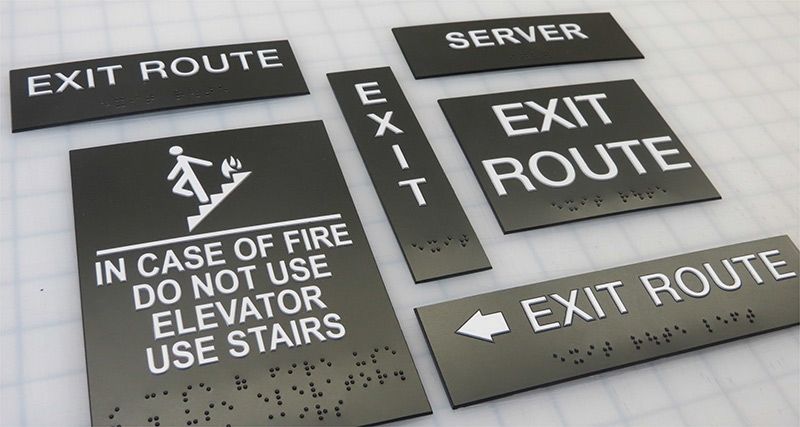The Influence of ADA Signs on Area Access
The Influence of ADA Signs on Area Access
Blog Article
Checking Out the Key Attributes of ADA Indications for Enhanced Access
In the world of accessibility, ADA signs serve as quiet yet effective allies, making certain that areas are inclusive and navigable for people with disabilities. By incorporating Braille and responsive components, these indicators damage barriers for the aesthetically impaired, while high-contrast shade plans and understandable fonts cater to varied visual needs.
Significance of ADA Compliance
Guaranteeing compliance with the Americans with Disabilities Act (ADA) is vital for cultivating inclusivity and equal accessibility in public areas and offices. The ADA, enacted in 1990, mandates that all public facilities, companies, and transport services fit people with handicaps, guaranteeing they take pleasure in the very same civil liberties and chances as others. Conformity with ADA requirements not only fulfills lawful responsibilities however additionally enhances a company's track record by demonstrating its commitment to diversity and inclusivity.
One of the essential aspects of ADA compliance is the application of easily accessible signs. ADA signs are developed to make sure that individuals with specials needs can quickly navigate through rooms and buildings.
Additionally, adhering to ADA guidelines can reduce the danger of legal effects and prospective penalties. Organizations that fall short to conform with ADA guidelines may face charges or lawsuits, which can be both harmful and monetarily troublesome to their public photo. Hence, ADA compliance is essential to promoting an equitable environment for everyone.
Braille and Tactile Components
The unification of Braille and responsive components right into ADA signs personifies the concepts of availability and inclusivity. These functions are crucial for individuals who are blind or visually impaired, allowing them to browse public spaces with higher freedom and confidence. Braille, a tactile writing system, is crucial in offering composed details in a format that can be easily viewed via touch. It is generally put under the corresponding text on signs to make certain that individuals can access the info without aesthetic aid.
Responsive aspects extend beyond Braille and include raised characters and symbols. These elements are created to be discernible by touch, allowing individuals to recognize area numbers, bathrooms, departures, and other vital areas. The ADA establishes details standards relating to the size, spacing, and positioning of these responsive aspects to enhance readability and ensure uniformity throughout different environments.

High-Contrast Color Design
High-contrast shade schemes play a pivotal duty in boosting the exposure and readability of ADA signage for people with visual problems. These plans are important as they take full advantage of the difference in light reflectance in between text and history, making sure that signs are quickly discernible, even from a distance. The Americans with Disabilities Act (ADA) mandates making use of specific shade contrasts to accommodate those with restricted vision, making it an essential element of conformity.
The efficiency of high-contrast colors depends on their capacity to stand apart in various illumination conditions, including dimly lit atmospheres and locations with glare. Generally, dark text on a light background or light message on a dark background is utilized to achieve ideal contrast. Black message on a yellow or white history provides a raw aesthetic distinction that assists in quick recognition and comprehension.

Legible Fonts and Text Size
When taking into consideration the style of ADA signage, the choice of clear fonts and ideal message dimension can not be overstated. The Americans with Disabilities Act (ADA) mandates that typefaces need to be not italic and sans-serif, oblique, manuscript, very decorative, or of unusual form.
The dimension of the text additionally plays a critical duty in access. According to ADA standards, the minimum text height need to be 5/8 inch, and it ought to increase proportionally with checking out distance. This is especially essential in public areas where signage requirements to be reviewed rapidly and precisely. Uniformity in message size adds to a cohesive visual experience, assisting individuals in navigating atmospheres effectively.
In addition, spacing between letters and lines is integral to see here legibility. Appropriate spacing protects against characters from appearing crowded, boosting readability. By sticking to these requirements, designers can significantly enhance availability, ensuring that signs offers its intended function for all individuals, no matter of their visual capabilities.
Efficient Placement Approaches
Strategic placement of ADA signs is necessary for making the most of availability and guaranteeing conformity with lawful standards. ADA standards state that indications ought to be mounted at a height in between 48 to 60 inches from the ground to guarantee they are within the line of sight for both standing and seated individuals.
In addition, indications should be placed adjacent to the lock side of doors to enable easy identification before entry. Uniformity in sign positioning throughout a facility boosts predictability, decreasing complication and improving total user experience.

Verdict
ADA indicators play an essential duty in advertising access by incorporating attributes that resolve the demands of people look here with specials needs. These aspects collectively foster an inclusive environment, emphasizing the relevance of ADA conformity in making sure equal gain access you can try this out to for all.
In the realm of accessibility, ADA indicators offer as quiet yet powerful allies, ensuring that rooms are inclusive and accessible for people with specials needs. The ADA, passed in 1990, mandates that all public facilities, companies, and transport solutions accommodate individuals with handicaps, guaranteeing they take pleasure in the same rights and possibilities as others. ADA Signs. ADA indicators are created to make sure that individuals with disabilities can conveniently browse with areas and structures. ADA guidelines stipulate that signs should be installed at a height in between 48 to 60 inches from the ground to ensure they are within the line of view for both standing and seated individuals.ADA indicators play a crucial role in advertising accessibility by incorporating features that resolve the needs of people with impairments
Report this page